SINGLE COUNTRY DECLARATION
Incheon Declaration

Incheon DeclarationEducation 2030: Towards inclusive and equitable quality education and lifelong learning for allPreamble1.We, Ministers, heads and members of delegations, heads of agencies andofficials of multilateral and bilateral organizations, and representatives of civil society, the teaching profession, youth and the private sector, have gathered in May 2015 at the invitation of the Director-General of UNESCO in Incheon, Republic of Korea, for the World Education Forum 2015 (WEF 2015). We thank the Government and the people of the Republic of Korea for having hosted this important event as well as UNICEF, the World Bank, UNFPA, UNDP, UN Women and UNHCR, as the co-convenors of this meeting, for their contributions. We express our sincere appreciation to UNESCO for having initiated and led the convening of this milestone event for Education 2030.2. On this historic occasion, we reaffirm the vision of the worldwide movement forEducation for All initiated in Jomtien in 1990 and reiterated in Dakar in 2000 — the most important commitment to education in recent decades and which has helped drive significant progress in education. We also reaffirm the vision and political will reflected in numerous international and regional human rights treaties that stipulate the right to education and its interrelation with other human rights. We acknowledge the efforts made; however, we recognize with great concern that we are far from having reached education for all.3. We recall the Muscat Agreement developed through broad consultations andadopted at the Global Education for All (EFA) Meeting 2014, and which successfully informed the proposed education targets of the Open Working Group on Sustainable Development Goals (SDGs). We further recall the outcomes of the regional ministerial conferences on education post-2015 and take note of the findings of the 2015 EFA Global Monitoring Report and the Regional EFA Synthesis Reports. We recognize the important contribution of the Global Education First Initiative as well as the role of governments and regional, intergovernmental and non-governmental organizations in galvanizing political commitment for education.4. Having taken stock of progress made towards the EFA goals since 2000 and the education-related Millennium Development Goals (MDGs) as well as the lessons learned, and having examined the remaining challenges and deliberated on the proposed 2030 education agenda and the Framework for Action as well as on future priorities and strategies for its achievement, we adopt this Declaration.Towards 2030: a new vision for education5. Our vision is to transform lives through education, recognizing the important role of education as a main driver of development and in achieving the other proposed SDGs. We commit with a sense of urgency to a single, renewed education agenda that is holistic, ambitious and aspirational, leaving no one behind. This new vision is fully captured by the proposed SDG 4 “Ensure inclusive and equitable quality education and promote lifelong learning opportunities for all” and its corresponding targets. It is transformative and universal, attends to the ‘unfinished business’ of the EFA agenda and the education-related MDGs, and addresses global and national education challenges. It is inspired by a humanistic vision of education and development based on human rights and dignity; social justice; inclusion; protection; cultural, linguistic and ethnic diversity; and shared responsibility and accountability. We reaffirm that education is a public good, a fundamental human right and a basis for guaranteeing the realization of other rights. It is essential for peace, tolerance, human fulfilment and sustainable development. We recognize education as key to achieving full employment and poverty eradication. We will focus our efforts on access, equity and inclusion, quality and learning outcomes, within a lifelong learning approach.6. Motivated by our significant achievements in expanding access to education over the last 15 years, we will ensure the provision of 12 years of free, publicly funded, equitable quality primary and secondary education, of which at least nine years are compulsory, leading to relevant learning outcomes. We also encourage the provision of at least one year of free and compulsory quality pre-primary education and that all children have access to quality early childhood development, care and education. We also commit to providing meaningful education and training opportunities for the large population of out-of-school children and adolescents, who require immediate, targeted and sustained action ensuring that all children are in school and are learning.7. Inclusion and equity in and through education is the cornerstone of a transformative education agenda, and we therefore commit to addressing all forms of exclusion and marginalization, disparities and inequalities in access, participation and learning outcomes. No education target should be considered met unless met by all. We therefore commit to making the necessary changes ineducation policies and focusing our efforts on the most disadvantaged, especially those with disabilities, to ensure that no one is left behind.8. We recognize the importance of gender equality in achieving the right to education for all. We are therefore committed to supporting gender-sensitive policies, planning and learning environments; mainstreaming gender issues in teacher training and curricula; and eliminating gender-based discrimination and violence in schools.9. We commit to quality education and to improving learning outcomes, which requires strengthening inputs, processes and evaluation of outcomes and mechanisms to measure progress. We will ensure that teachers and educators are empowered, adequately recruited, well-trained, professionally qualified, motivated and supported within well-resourced, efficient and effectively governed systems. Quality education fosters creativity and knowledge, and ensures the acquisition of the foundational skills of literacy and numeracy as well as analytical, problem-solving and other high-level cognitive, interpersonal and social skills. It also develops the skills, values and attitudes that enable citizens to lead healthy and fulfilled lives, make informed decisions, and respond to local and global challenges through education for sustainable development (ESD) and global citizenship education (GCED). In this regard, we strongly support the implementation of the Global Action Programme on ESD launched at the UNESCO World Conference on ESD in Aichi-Nagoya in 2014. We also stress the importance of human rights education and training in order to achieve the post-2015 sustainable development agenda.10. We commit to promoting quality lifelong learning opportunities for all, in all settings and at all levels of education. This includes equitable and increased access to quality technical and vocational education and training and higher education and research, with due attention to quality assurance. In addition, the provision of flexible learning pathways, as well as the recognition, validation and accreditation of the knowledge, skills and competencies acquired through non-formal and informal education, is important. We further commit to ensuring that all youth and adults, especially girls and women, achieve relevant and recognized functional literacy and numeracy proficiency levels and acquire life skills, and that they are provided with adult learning, education and training opportunities. We are also committed to strengthening science, technology and innovation. Information and communication technologies (ICTs) must be harnessed to strengthen education systems, knowledge dissemination, information access, quality and effective learning, and more effective service provision.11. Furthermore, we note with serious concern that, today, a large proportion of the world’s out-of-school population lives in conflict-affected areas, and that crises, violence and attacks on education institutions, natural disasters and pandemics continue to disrupt education and development globally. We commit to developing more inclusive, responsive and resilient education systems to meet the needs of children, youth and adults in these contexts, including internally displaced persons and refugees. We highlight the need for education to be delivered in safe, supportive and secure learning environments free from violence. We recommend a sufficient crisis response, from emergency response through to recovery and rebuilding; better coordinated national, regional and global responses; and capacity development for comprehensive risk reduction and mitigation to ensure that education is maintained during situations of conflict, emergency, post-conflict and early recovery.Implementing our common agenda12. We reaffirm that the fundamental responsibility for successfully implementing this agenda lies with governments. We are determined to establish legal and policy frameworks that promote accountability and transparency as well as participatory governance and coordinated partnerships at all levels and across sectors, and to uphold the right to participation of all stakeholders.13. We call for strong global and regional collaboration, cooperation, coordination and monitoring of the implementation of the education agenda based on data collection, analysis and reporting at the country level, within the framework of regional entities, mechanisms and strategies.14. We recognize that the success of the 2030 education agenda requires sound policies and planning as well as efficient implementation arrangements. It is also clear that the aspirations encompassed in the proposed SDG 4 cannot be realized without a significant and well-targeted increase in financing, particularly in those countries furthest from achieving quality education for all at all levels. We therefore are determined to increase public spending on education in accordance with country context, and urge adherence to the international and regional benchmarks of allocating efficiently at least 4 - 6% of Gross Domestic Product and/or at least 15 - 20% of total public expenditure to education.15. Noting the importance of development cooperation in complementing investments by governments, we call upon developed countries, traditional and emerging donors, middle income countries and international financingmechanisms to increase funding to education and to support the implementation of the agenda according to countries’ needs and priorities. We recognize that the fulfilment of all commitments related to official development assistance (ODA) is crucial, including the commitments by many developed countries to achieve the target of 0.7 per cent of gross national product (GNP) for ODA to developing countries. In accordance with their commitments, we urge those developed countries that have not yet done so to make additional concrete efforts towards the target of 0.7 per cent of GNP for ODA to developing countries. We also commit to increase our support to the least developed countries. We further recognize the importance of unlocking all potential resources to support the right to education. We recommend improving aid effectiveness through better coordination and harmonization, and prioritizing financing and aid to neglected sub-sectors and low income countries. We also recommend significantly increasing support for education in humanitarian and protracted crises. We welcome the Oslo Summit on Education for Development (July 2015) and call on the Financing for Development Conference in Addis Ababa to support the proposed SDG 4.16. We call on the WEF 2015 co-convenors, and in particular UNESCO, as well as on all partners, to individually and collectively support countries in implementing the 2030 education agenda, by providing technical advice, national capacity development and financial support based on their respective mandates and comparative advantages, and building on complementarity. To this end, we entrust UNESCO, in consultation with Member States, the WEF 2015 co-convenors and other partners, to develop an appropriate global coordination mechanism. Recognizing the Global Partnership for Education as a multi-stakeholder financing platform for education to support the implementation of the agenda according to the needs and priorities of the countries, we recommend that it be part of this future global coordination mechanism.17. We further entrust UNESCO, as the United Nations’ specialized agency for education, to continue its mandated role to lead and coordinate the 2030 education agenda, in particular by: undertaking advocacy to sustain political commitment; facilitating policy dialogue, knowledge sharing and standard setting; monitoring progress towards the education targets; convening global, regional and national stakeholders to guide the implementation of the agenda; and functioning as a focal point for education within the overall SDG coordination architecture.18. We resolve to develop comprehensive national monitoring and evaluation systems in order to generate sound evidence for policy formulation and the management of education systems as well as to ensure accountability. We further request the WEF 2015 co-convenors and partners to support capacity development in data collection, analysis and reporting at the country level. Countries should seek to improve the quality, levels of disaggregation and timeliness of reporting to the UNESCO Institute for Statistics. We also request that the Education for All Global Monitoring Report be continued as an independent Global Education Monitoring Report (GEMR), hosted and published by UNESCO, as the mechanism for monitoring and reporting on the proposed SDG 4 and on education in the other proposed SDGs, within the mechanism to be established to monitor and review the implementation of the proposed SDGs.19. We have discussed and agreed upon the essential elements of the Education 2030 Framework for Action. Taking into account the United Nations summit for the adoption of the post-2015 development agenda (New York, September 2015) and the outcomes of the Third International Conference on Financing for Development (Addis Ababa, July 2015), a final version will be presented for adoption and launched at a special high-level meeting to be organized alongside the 38th session of the General Conference of UNESCO in November 2015. We are fully committed to its implementation after its adoption, to inspire and guide countries and partners to ensure that our agenda is achieved.20. Building on the legacy of Jomtien and Dakar, this Incheon Declaration is an historic commitment by all of us to transform lives through a new vision for education, with bold and innovative actions, to reach our ambitious goal by 2030.。
海关总署公告2011年第11号-流动证明格式
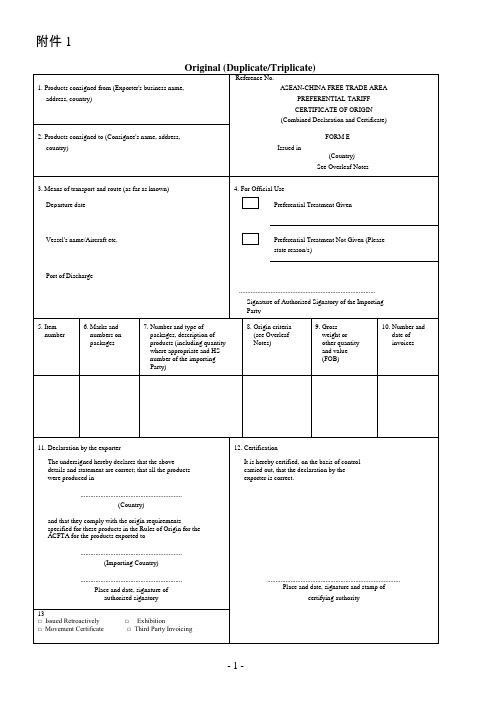
附件1OVERLEAF NOTES1. Parties which accept this form for the purpose of preferential treatment under the ASEAN-CHINA Free Trade Area PreferentialTariff:BRUNEI DARUSSALAM CAMBODIA CHINAINDONESIA LAOS MALAYSIAMYANMAR PHILIPPINES SINGAPORETHAILAND VIETNAM2. CONDITIONS: The main conditions for admission to the preferential treatment under the ACFTA Preferential Tariff are thatproducts sent to any Parties listed above:(i)must fall within a description of products eligible for concessions in the country of destination;(ii)must comply with the consignment conditions that the products must be consigned directly from any ACFTA Party to the importing Party but transport that involves passing through one or more intermediate non-ACFTA Parties, is also accepted provided that any intermediate transit, transshipment or temporary storage arises only for geographic reasons or transportation requirements; and(iii)must comply with the origin criteria given in the next paragraph.3. ORIGIN CRITERIA: For exports to the above mentioned countries to be eligible for preferential treatment, the requirement is thateither:(i)The products wholly obtained in the exporting Party as defined in Rule 3 of the Rules of Origin for the ACFTA;(ii)Subject to sub-paragraph (i) above, for the purpose of implementing the provisions of Rule 2 (b) of the Rules of Origin for the ACFTA, products worked on and processed as a result of which the total value of the materials, parts or produce originating from non-ACFTA Parties or of undetermined origin used does not exceed 60% of the FOB value of the product produced or obtained and the final process of the manufacture is performed within territory of the exporting Party;(iii)Products which comply with origin requirements provided for in Rule 2 of the Rules of Origin for the ACFTA and which are used in a Party as inputs for a finished product eligible for preferential treatment in another Party/Parties shall be considered as a product originating in the Party where working or processing of the finished product has taken place provided that the aggregate ACFTA content of the final product is not less than 40%; or(iv)Products which satisfy the Product Specific Rules provided for in Attachment B of the Rules of Origin for the ACFTA shall be considered as products to which sufficient transformation has been carried out in a Party.If the products qualify under the above criteria, the exporter must indicate in Box 8 of this form the origin criteria on the basis of which he claims that his products qualify for preferential treatment, in the manner shown in the following table:4. EACH ARTICLE MUST QUALIFY: It should be noted that all the products in a consignment must qualify separately in their ownright. This is of particular relevance when similar articles of different sizes or spare parts are sent.5. DESCRIPTION OF PRODUCTS: The description of products must be sufficiently detailed to enable the products to be identified bythe Customs Officers examining them. Name of manufacturer, any trade mark shall also be specified.6. The Harmonised System number shall be that of the importing Party.7. The term “Exporter” in Box 11 may include the manufacturer or the producer. In the case of MC the term “Exporter” also includesthe exporter in the intermediate Party,8. FOR OFFICIAL USE: The Customs Authority of the importing Party must indicate ( ) in the relevant boxes in column 4 whetheror not preferential treatment is accorded9. Movement Certificate: In cases of Movement Certificate, in accordance with Rule 12 of the Operational CertificationProcedures, “Movement Certificate” in Box 13 should be ticked (√). The name of original Issuing Authorities of the Party, dateof the issuance and the reference number of the original Certificate of Origin (Form E) to be indicated in Box 13.10. THIRD PARTY INVOICING: In cases where invoices are issued by a third country, “the Third Party Invoicing” in Box 13 shall beticked (√). The invoice number shall be indicate d in Box 10. Information such as name and country of the company issuing the invoice shall be indicated in Box 7.11. EXHIBITIONS: In cases where products are sent from the exporting Party for exhibition in another Party and sold during orafter the exhibition for importation into a Party, in accordance with Rule 22 of Attachment A of the Rules of Origin for theACFTA, the “Exhibitions” in Box 13 should be ticked (√) and the name and address of the exhibition indicated in Box 2.12. ISSUED RETROACTIVELY: In exceptional cases, due to involuntary errors or omissions or other valid causes, the Certificateof Origin (Form E) may be issued retroactively in accordance with Rule 11 of Attachment A of the Rules of Origin for theACFTA. The “Issued Retroactively” in Box 13 shall be ticked (√).背页说明1.为享受中国-东盟自由贸易区优惠关税协议下优惠待遇而接受本证书的缔约各方:文莱、柬埔寨、中国、印度尼西亚、老挝、马来西亚、缅甸、菲律宾、新加坡、泰国、越南2.条件:出口至上述任一方的产品,享受中国-东盟自由贸易区优惠关税协议下优惠待遇的主要条件是:必须是在目的国可享受关税减让的产品;必须符合产品由中国东盟自由贸易区任一方直接运至进口方的运输条件,但如果过境运输、转换运输工具或临时储存仅是由于地理原因或仅出于运输需要的考虑,运输途中经过一个或多个中国-东盟自由贸易区非缔约方境内的运输亦可接受;以及必须符合下述的原产地标准。
外贸英语口语外贸专用证书都有哪些(标准翻译)
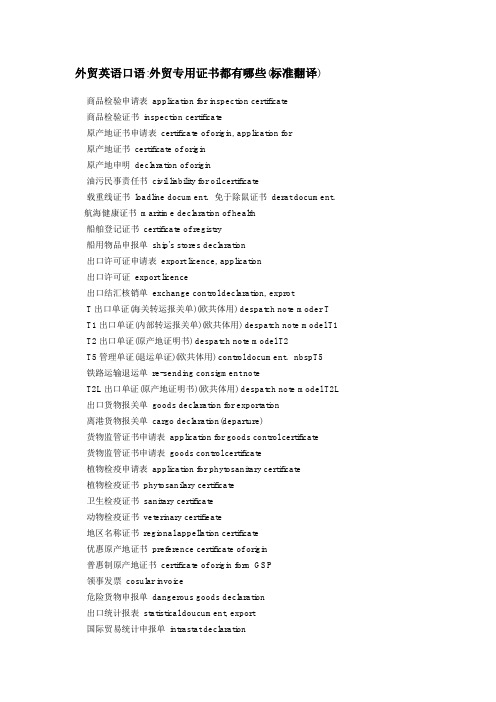
外贸英语口语:外贸专用证书都有哪些(标准翻译)商品检验申请表application for inspection certificate商品检验证书inspection certificate原产地证书申请表certificate of origin, application for原产地证书certificate of origin原产地申明declaration of origin油污民事责任书civil liability for oil certificate载重线证书loadline document.免于除鼠证书derat document.航海健康证书maritime declaration of health船舶登记证书certificate of registry船用物品申报单ship's stores declaration出口许可证申请表export licence, application出口许可证export licence出口结汇核销单exchange control declaration, exprotT出口单证(海关转运报关单)(欧共体用) despatch note moder T T1出口单证(内部转运报关单)(欧共体用) despatch note model T1 T2出口单证(原产地证明书) despatch note model T2T5管理单证(退运单证)(欧共体用) control document.nbspT5铁路运输退运单re-sending consigment noteT2L出口单证(原产地证明书)(欧共体用) despatch note model T2L 出口货物报关单goods declaration for exportation离港货物报关单cargo declaration(departure)货物监管证书申请表application for goods control certificate货物监管证书申请表goods control certificate植物检疫申请表application for phytosanitary certificate植物检疫证书phytosanilary certificate卫生检疫证书sanitary certificate动物检疫证书veterinary certifieate地区名称证书regional appellation certificate优惠原产地证书preference certificate of origin普惠制原产地证书certificate of origin form GSP领事发票cosular invoice危险货物申报单dangerous goods declaration出口统计报表statistical doucument, export国际贸易统计申报单intrastat declaration交货核对证明delivery verification certificate进口许可证申请表import licence, application for进口许可证import licence无商业细节的报关单customs declaration without commercial detail有商业和项目细节的报关单customs declaration with commercial and item detail 无项目细节的报关单customs declaration without item detail有关单证related document.海关收据receipt (Customs)调汇申请application for exchange allocation调汇许可foreign exchange permit进口外汇管理申报exchange control declaration (import)进口货物报关单goods declaration for implortation内销货物报关单goods declaration for home use海关即刻放行报关单customs immediate release declaration海关放行通知customs delivery note到港货物报关单cargo declaration (arrival)货物价值申报清单value declaration海关发票customs invoice邮包报关单customs deciaration (post parcels)增值税申报单tax declaration (value added tax)普通税申报单tax declaration (general)催税单tax demand禁运货物许可证embargo permit海关转运货物报关单goods declaration for customs transitTIF国际铁路运输报关单TIF formTIR国际公路运输报关单TIR carnet欧共体海关转运报关单EC carnetEUR1欧共体原产地证书EUR 1 certificate of origin暂准进口海关文件ATA carnt欧共体统一单证single administrative document.海关一般回复general response (Customs)海关公文回复document.nbspresponse (Customs)海关误差回复error response (Customs)海关一揽子回复packae response (Customs)海关计税/确认回复tax calculation /confirmation response (Customs)配额预分配证书quota prior allocation certificate最终使用授权书end use authorization政府合同government contract进口统计报表statistical document.import跟单信用证开证申请书application for document.ry credit 英语口语培训/。
爱尔兰签证declaration模板
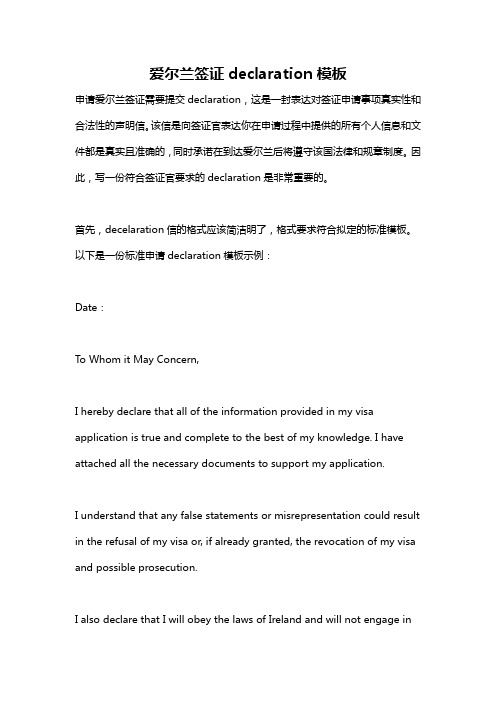
爱尔兰签证declaration模板申请爱尔兰签证需要提交declaration,这是一封表达对签证申请事项真实性和合法性的声明信。
该信是向签证官表达你在申请过程中提供的所有个人信息和文件都是真实且准确的,同时承诺在到达爱尔兰后将遵守该国法律和规章制度。
因此,写一份符合签证官要求的declaration是非常重要的。
首先,decelaration信的格式应该简洁明了,格式要求符合拟定的标准模板。
以下是一份标准申请declaration模板示例:Date:To Whom it May Concern,I hereby declare that all of the information provided in my visa application is true and complete to the best of my knowledge. I have attached all the necessary documents to support my application.I understand that any false statements or misrepresentation could result in the refusal of my visa or, if already granted, the revocation of my visa and possible prosecution.I also declare that I will obey the laws of Ireland and will not engage inany unlawful activities during my stay in the country.Thank you for considering my visa application.Sincerely,[Full Name]其次,declaration信应清楚明白地表达你的意图和正确的信息。
单一窗口出口货物申报流程
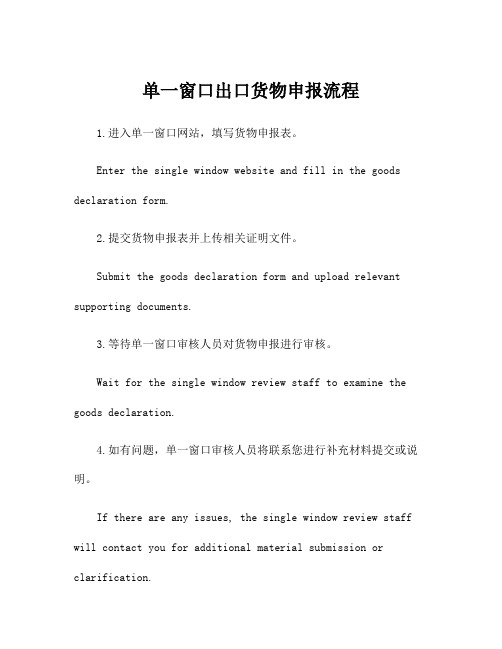
单一窗口出口货物申报流程1.进入单一窗口网站,填写货物申报表。
Enter the single window website and fill in the goods declaration form.2.提交货物申报表并上传相关证明文件。
Submit the goods declaration form and upload relevant supporting documents.3.等待单一窗口审核人员对货物申报进行审核。
Wait for the single window review staff to examine the goods declaration.4.如有问题,单一窗口审核人员将联系您进行补充材料提交或说明。
If there are any issues, the single window review staff will contact you for additional material submission or clarification.5.审核通过后,您将收到货物申报的批准通知。
After the review is approved, you will receive a notification of approval for the goods declaration.6.根据单一窗口的指示,缴纳相应的关税和税费。
Pay the corresponding customs duties and taxes according to the instructions of the single window.7.办理货物出口手续,并获取出口货物的通关单证。
Complete the export procedures for the goods and obtain the clearance documents for export goods.8.将通关单证交给相关出口货物的物流公司。
产地证明(共5篇)
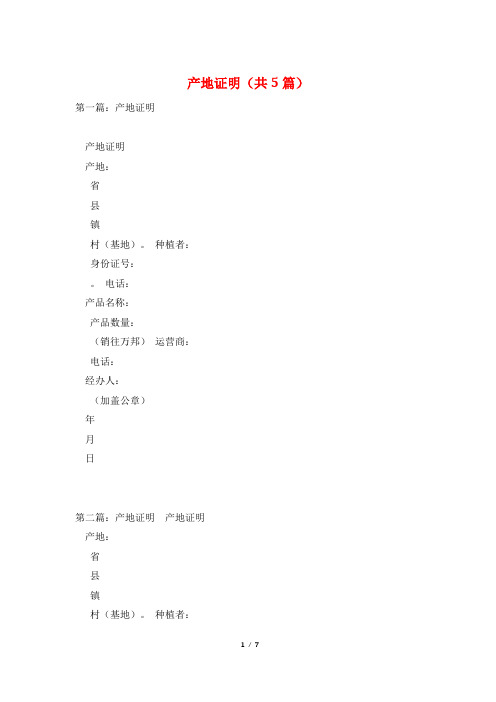
产地证明(共5篇)第一篇:产地证明产地证明产地:省县镇村(基地)。
种植者:身份证号:。
电话:产品名称:产品数量:(销往万邦)运营商:电话:经办人:(加盖公章)年月日第二篇:产地证明产地证明产地:省县镇村(基地)。
种植者:身份证号:。
电话:产品名称:产品数量:(销往万邦)运营商:电话:经办人:(加盖公章)年月日第三篇:苗木产地证明样本苗木产地证明(样本)兹证明以下苗木系丽岙花木场(园艺场、苗圃、公司)自育苗木:以上情况属实、经办人自愿承担一切后果责任;经办人(签字)丽岙花木场(公司)盖章年月日附:树木照片样本第四篇:产地类证明文件目前我们国家有多少种原产地类证明文件,都是用于那种情况?一、普惠制原产地证明书(FORM A)使用范围:惠制原产地证书是具有法律效力的我国出口产品在给惠国享受在最惠国税率基础上进一步减免进口关税的官方凭证。
二、一般原产地证明书(CO)一般原产地证书是证明货物原产于某一特定国家或地区,享受进口国正常关税(最惠国)待遇的证明文件。
它的适用范围是:征收关税、贸易统计、保障措施、歧视性数量限制、反倾销和反补贴、原产地标记、政府采购等方面。
三、区域性经济集团互惠原产地证书目前主要有《〈中国-东盟自由贸易区〉优惠原产地证明书》、《亚太贸易协定》原产地证明书、《〈中国与巴基斯坦优惠贸易安排〉优惠原产地证明书》《〈中国—智利自贸区〉原产地证书》等。
区域优惠原产地证书是具有法律效力的在协定成员国之间就特定产品享受互惠减免关税待遇的官方凭证。
1、《中国-东盟自由贸易区》优惠原产地证明书(FORM E)自2004年1月1日起,凡出口到东盟的农产品(HS第一章到第八章)凭借检验检疫机构签发的《中国-东盟自由贸易区》(FORM E)优惠原产地证书可以享受关税优惠待遇。
2005年7月20日起,7000多种正常产品开始全面降税。
中国和东盟六个老成员国(即文莱、印度尼西亚、马来西亚、菲律宾、新加坡和泰国)至2005年7月40%税目的关税降到0-5%;2007年1月60%税目的关税要降到0-5%。
单身证明公证书

购房单身证明----亲身体会购房时,若主贷人已婚则需结婚证件,若未婚22周岁以下需现场签未婚声明,未婚但满22周岁需提供单身证明(有些银行需要公证处办的单身公证)。
以下是办理单身证明和单身公证的流程:一、单身证明要开单身证明,必须到本人户口所在地的乡镇民政办或区县民政局开单身证明。
其实很简单的,他们只需要查阅一下系统是否你在他们管辖区域有过婚姻登记,草率点的话只需要看下你的户口本和身份证件,再问下你有没有婚姻登记过,然后就直接给你打印一份他们的样本,盖下他们民政办的章就ok。
二、单身公证本人持单身证明、户口本、身份证件到户口所辖区县公证处办理,其他地方公证处应该也可以办理,只要是有资质和国家认可的机构。
流程如下:1、到公证处后,公证员会让你复印单身证明、户口本、身份证各一份。
2、打印5份他们所要的《未婚声明书》,他们电脑里存的有。
3、拿到以上材料后,他们给你开一张缴费单,到财务室缴钱,单身公证是300.我看他们有的办公积金委托公证的是800(具体我也没有怎么问)。
4、钱送给他们后,他们就可以高兴地让你签字和捺手印了,再给你很多张资料,你也用不着管那是什么,签字捺手印就行,那些资料都要存档的。
5、再打印5份他们所要的《公证书》,他们电脑存的有。
6、以上资料都齐全了,他们就给你封装成书,然后给你捺上公证员签名、盖章、封面压钢印。
7、总共一式五份,你带走四份,他们留一份存档,ok,可以闪人咯。
篇二:未婚公证书未婚公证书未婚公证书( )____字第____号根据____________单位证明(或经调查),兹证明____________(男或女,现住______省______市______街______号)至______年______月______日(单位出具的证明或公证处查证的时间)未曾登记结婚。
______的父亲是______,______的母亲是______。
中华人民共和国___省___市公证处公证员:______________(签名) ________年________月________日第1页共1页篇三:美国单身证明公证认证美国单身证明公证认证一、根据《中华人民共和国婚姻法》有关规定,结婚年龄,男不得早于22周岁,女不得早于20周岁。
手持便携式动力工具 振动试验方法 第13部分:紧固件驱动工具-最新国标
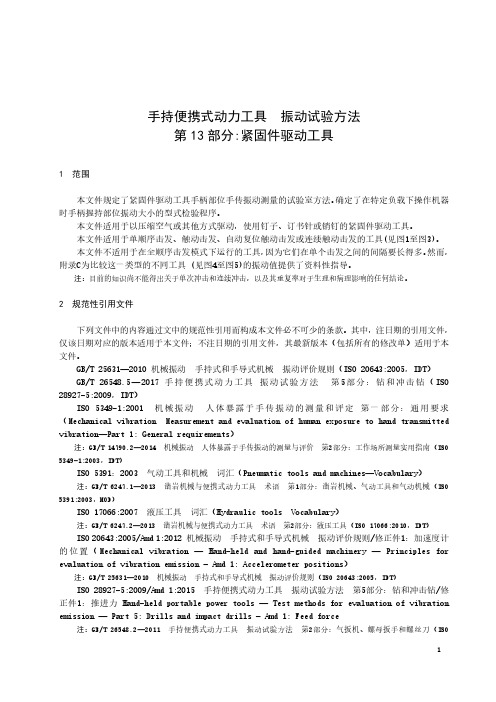
手持便携式动力工具振动试验方法第13部分:紧固件驱动工具1 范围本文件规定了紧固件驱动工具手柄部位手传振动测量的试验室方法。
确定了在特定负载下操作机器时手柄握持部位振动大小的型式检验程序。
本文件适用于以压缩空气或其他方式驱动,使用钉子、订书针或销钉的紧固件驱动工具。
本文件适用于单顺序击发、触动击发、自动复位触动击发或连续触动击发的工具(见图1至图3)。
本文件不适用于在全顺序击发模式下运行的工具,因为它们在单个击发之间的间隔要长得多。
然而,附录C为比较这一类型的不同工具 (见图4至图5)的振动值提供了资料性指导。
注:目前的知识尚不能得出关于单次冲击和连续冲击,以及其重复率对于生理和病理影响的任何结论。
2 规范性引用文件下列文件中的内容通过文中的规范性引用而构成本文件必不可少的条款。
其中,注日期的引用文件,仅该日期对应的版本适用于本文件;不注日期的引用文件,其最新版本(包括所有的修改单)适用于本文件。
GB/T 25631—2010 机械振动手持式和手导式机械振动评价规则(ISO 20643:2005,IDT)GB/T 26548.5—2017 手持便携式动力工具振动试验方法第5部分:钻和冲击钻(ISO 28927-5:2009,IDT)ISO 5349-1:2001 机械振动人体暴露于手传振动的测量和评定第一部分:通用要求(Mechanical vibration Measurement and evaluation of human exposure to hand transmitted vibration—Part 1: General requirements)注:GB/T 14790.2—2014 机械振动人体暴露于手传振动的测量与评价第2部分:工作场所测量实用指南(ISO 5349-1:2003,IDT)ISO 5391:2003 气动工具和机械词汇(Pneumatic tools and machines—Vocabulary)注:GB/T 6247.1—2013 凿岩机械与便携式动力工具术语第1部分:凿岩机械、气动工具和气动机械(ISO 5391:2003,MOD)ISO 17066:2007 液压工具词汇(Hydraulic tools Vocabulary)注:GB/T 6247.2—2013 凿岩机械与便携式动力工具术语第2部分:液压工具(ISO 17066:2010,IDT)ISO 20643:2005/Amd 1:2012 机械振动手持式和手导式机械振动评价规则/修正件1:加速度计的位置(Mechanical vibration —Hand-held and hand-guided machinery —Principles for evaluation of vibration emission – Amd 1: Accelerometer positions)注:GB/T 25631—2010 机械振动手持式和手导式机械振动评价规则(ISO 20643:2005,IDT)ISO 28927-5:2009/Amd 1:2015 手持便携式动力工具振动试验方法第5部分:钻和冲击钻/修正件1:推进力 Hand-held portable power tools — Test methods for evaluation of vibration emission — Part 5: Drills and impact drills – Amd 1: Feed force注:GB/T 26548.2—2011 手持便携式动力工具振动试验方法第2部分:气扳机、螺母扳手和螺丝刀(ISO28927-2:2009,IDT)EN 12096:1997 机械振动振动辐射值的标示和验证(Mechanical vibration—Declaration and verification of vibration emission values)3 术语和定义GB/T 25631—2010、ISO 5391:2003和ISO 17066:2007界定的及下列术语、定义和符号适用于本文件。
